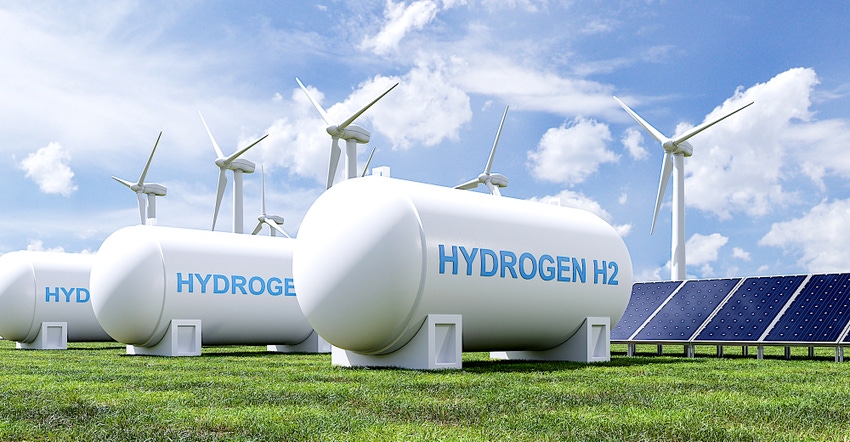Forvia Is Positioning for Hydrogen Vehicle Dominance
Forvia wants to provide both hydrogen fuel storage tanks and the fuel cells that will employ them.

Forvia is shipping Type IV hydrogen tanks from its production plant in Allenjoie, France, with the goal of making 100,000 of the tanks annually. The company delivered 13,000 of the carbon fiber hydrogen tanks in 2022, and shipments are running 50 percent above that level in 2023, according to Forvia's senior vice president of hydrogen solutions, Yves Dumoulin.
Forvia, the world’s seventh-largest automotive supplier that was created in 2022 by the merger of French supplier Faurecia and German lighting specialist Hella, is aiming to be a dominant player in the market for hydrogen fuel cell vehicles.
Forvia is delivering tanks for vehicles to customers such as Stellantis, Hyvia, and MAN, but the polymer-lined carbon fiber Type IV tanks are intended for Forvia’s Large-Scale Hydrogen Storage Solution. This is a hydrogen storage and distribution product for the hydrogen-powered aviation company, Electra (known as AirFlow until recently).
Mass production at the new Allenjoie plant has the potential to slash the tanks’ cost to just one-fifth of today’s cost by 2025, according to the company. The goal of building 100,000 tanks a year is for the “mid-term,” Forvia says.
Since 2018, Forvia has invested more than €380 million in hydrogen technology development, in pursuit of a market that it expects to grow to €20 billion by 2030. Forvia and Symbio, its fuel cell stack joint venture with Michelin and Stellantis, have together booked orders for hydrogen products worth €1.2 billion. Stellantis joined the Symbio partnership in August. Forvia’s stated goal is to garner €3.5 billion in annual sales of the predicted €20 billion market in 2030.

To get there, Dumoulin identifies some key challenges to be addressed: Affordability and convenience. “Affordability, not only at the level of the tank, the storage system, but also at the level of the refilling,” he said in a Forvia Talks video. “It is very important that we enable the customer to have access to the most affordable mobility possible.”
On the convenience side, Dumoulin cites the convenience of refilling gasoline-powered cars as the benchmark consumers expect future vehicles to match. “The charging time (of battery EVs) sometimes is painful,” he said.
“This is why there is a space for hydrogen,” Dumoulin continued. “This is why hydrogen is relevant technology. We want to move forward in this direction and make hydrogen even more convenient for the end user through the ease of refilling the car in three to five minutes, like a gasoline vehicle.”
Dumoulin cites two technologies as key to addressing these challenges: Conformable hydrogen tanks and liquid hydrogen fuel. Conformable tanks are boxy shapes that are designed to fill all of the available vacant space with hydrogen storage. “The advantage of this technology is that, in the same environment, in the same shape, you can put much more hydrogen than in a collection of cylinders,” he said.

Another advantage, he pointed out, is the similarity in shape of the conformable tank to that of a battery pack. This means that carmakers can install hydrogen storage into the same space in a vehicle that is otherwise used for batteries, letting them build both fuel cell and battery-electric versions of the same vehicles. “You don’t need to develop two different vehicles,” he pointed out.
Then there’s the matter of the cost of hydrogen fuel. Liquid hydrogen’s greater density than compressed gaseous hydrogen can help deliver savings to drivers, Dumoulin predicts. To exploit this potential, Forvia is developing cryogenic tanks for vehicles, a variation on the kinds of tanks employed today by liquid hydrogen-fueled rockets.
“Liquid hydrogen offers an important benefit in terms of energy density and probably as well a benefit in terms of hydrogen cost,” said Dumoulin, explaining the necessity of developing cryogenic tanks. “Because when you are going to the station and you are refilling your tank, liquid hydrogen may be even cheaper than compressed hydrogen.”
Dumoulin predicts that liquid hydrogen fuel and cryogenic tank technology could mature during the 2027-to-2030 time frame. It will be interesting to see how hydrogen fuel cells end up fitting into the EV landscape by then, but Forvia, its partners, and its customer companies are all pushing forward with confidence.
About the Author(s)
You May Also Like





